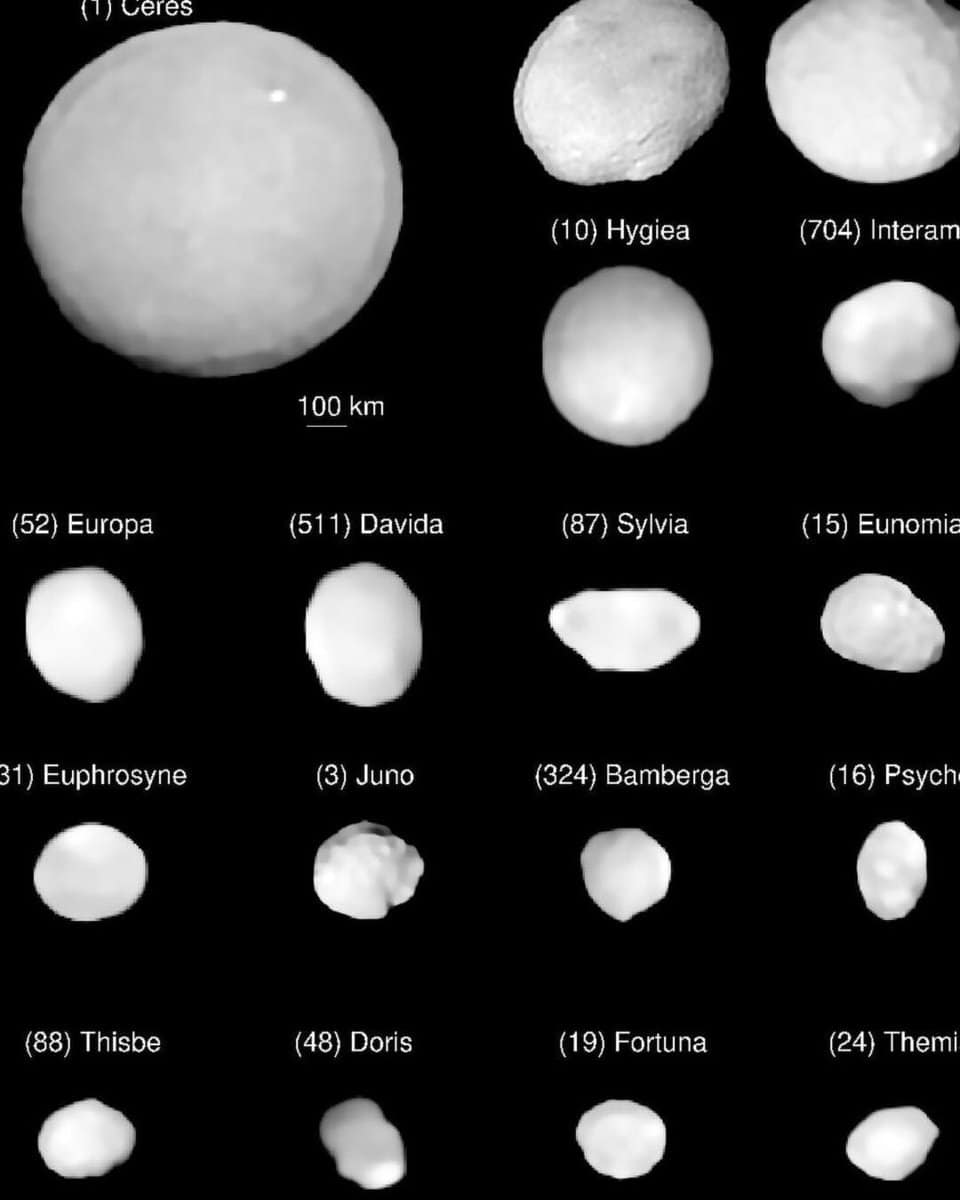In the past, Ceres used to be the largest asteroid, but it was reclassified as a dwarf planet, just like Pluto, in 2006. Pallada used to be the second largest asteroid, but further measurements revealed that it is actually a few kilometers smaller than the third largest asteroid, Vesta. Therefore, Vesta is now recognized as the largest asteroid in the entire solar system.
Distinctive Features of Vesta
Vesta can be found in the primary asteroid belt, situated between Mars and Jupiter. Its orbit is almost perfectly circular, completing one revolution every 3.63 years.

The main asteroid belt is home to Vesta, the largest asteroid. Although Vesta is nearly spherical, its dimensions of 578x560x458 kilometers deviate slightly from a perfect sphere. This irregularity is what sets it apart from being classified as a dwarf planet. If Vesta had a more uniform shape, it would meet the criteria for a dwarf planet designation.

A photograph of Vesta taken by the Dawn probe from a distance of 15,000 kilometers.
Vesta is more than just a massive asteroid. Its formation resembled the birth of an actual planet. Its interior also consists of a molten mantle and a hot iron-nickel core. Although these have now cooled down, Vesta is still abundant in a diverse range of rocks and minerals due to the high temperatures and pressures it experienced in the past. This has been confirmed through the study of meteorites that have fallen to Earth – some of which originated from Vesta itself.
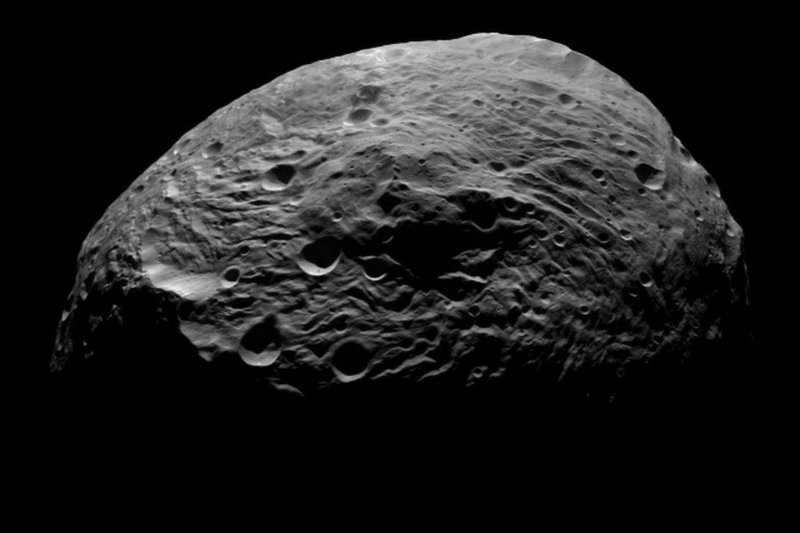
Vesta spins on its axis and completes one full rotation every 5 hours and 20 minutes. The surface temperature of Vesta ranges from -3 to -106 degrees Celsius.
Being a small celestial body, Vesta naturally lacks an atmosphere.
Vesta’s Surface
Situated in the asteroid belt, the largest asteroid in our solar system, Vesta, resides in a tumultuous neighborhood. As a consequence, its surface endures a constant barrage of numerous forces, resulting in the formation of numerous craters.

A detailed map of the asteroid Vesta has been created using data gathered by the Dawn probe. This topographic map provides valuable insights into the surface features of Vesta, including its largest crater, Reyasylvia, which is situated at the south pole. Reyasylvia has a distinctive cross-section measuring between 475-500 km and a depth of 20-25 km, making it one of the deepest craters in the entire solar system.
What sets Reyasylvia apart even further is its impressive central slide, which spans an impressive 180 km in diameter and reaches a height of 22 km. In fact, this slide is the second highest peak in the entire solar system, second only to the towering Olympus volcano on Mars, which reaches a staggering height of 26 km. In addition, Vesta’s Japeta Wall is the third highest peak, standing at a height of 20 km.

The Reyasylvia crater is located at the southern pole of Vesta.
Crater Reyasylvia is the result of a massive collision with another asteroid, and it is quite astonishing that Vesta was able to withstand it and remain intact. However, the impact was so powerful that it exposed all of the upper layers of Vesta’s crust down to the mantle.
There are numerous smaller craters in the vicinity of Vesta. These craters are part of the “Vesta family” and are classified as type V. It is likely that many of these craters were formed as a result of the same impact. They have a size of less than 10 kilometers and their number exceeds 6000.
There are numerous additional craters scattered across the expanse of Vesta. Several of these craters boast a diameter reaching 150 km and plunge to depths of 7 km. In certain regions, craters are plentiful, causing the surface to appear lighter in tone. Conversely, in other areas, craters are scarce, resulting in a much darker complexion. In fact, some regions even bear a striking resemblance to the lunar seas, featuring notably dark patches. This stark contrast can be attributed to the presence of distinct rock formations.
Exploration and Discovery of Vesta
Vesta, one of the major asteroids, was initially observed in 1807 by Heinrich Olbers, a German astronomer. Prior to its discovery, Olbers had already identified Ceres and Pallada, two other significant asteroids. The name “Vesta” was bestowed upon this celestial body by Carl Gauss, with the consent of Olbers.
In addition to his accomplishments, Olbers also made notable discoveries of several comets and was the first to propose the theory that asteroids were remnants of a destroyed planet called Phaeton. To honor Olbers, a lunar crater and the asteroid Olbersia were named after him.
Due to their immense distance and small size, studying asteroids from Earth is an incredibly challenging task. Even with the most cutting-edge telescopes available today, limited progress can be made. Therefore, the hope for advancing our understanding of asteroids lies in the exploration carried out by automated probes.
In 2007, NASA launched the “Dawn” probe specifically for the purpose of studying Vesta. On May 3, 2011, it captured its first image of the asteroid from a distance of 1.2 million kilometers, and on July 16, it successfully entered orbit around Vesta.
During its time in orbit, the probe transmitted numerous images and collected a wealth of valuable information about Vesta. Scientists were able to accurately calculate the asteroid’s mass based on its gravitational influence, and they also determined its rotation period and much more.
The “Dawn” probe remained in Vesta’s orbit until September 5, 2012, spending over a year studying the asteroid. It then embarked on a journey to another asteroid, Ceres, using its ion engines.
Observing Vesta
Vesta, the largest asteroid in the solar system, is located relatively close by cosmic standards. It can even come as close as 177 million kilometers to Earth. This means that during these times, Vesta can be visible in the sky without the need for a telescope, although using binoculars would certainly enhance the viewing experience.
For most of the year, Vesta cannot be seen with the naked eye. Its brightness ranges from 5.1 to 8.48 magnitude, making it visible with any telescope except during periods when it is behind the Sun.
While you won’t be able to see any specific details on Vesta, even with a powerful telescope, it will appear as a star. However, if you observe it over several nights, you will notice its movement against the backdrop of the other stars.
We hope you have many clear nights and enjoyable observations.

Based on disaster films, asteroids are often portrayed as one of humanity’s greatest foes, alongside viruses, zombies, and irresponsible politicians. Countless movies depict the catastrophic events that unfold on Earth following a collision with even a relatively small celestial object. The extensive catalog of these films includes tsunamis, earthquakes, climate change, and various other phenomena that offer little benefit to mankind.
The chance of the Earth colliding with an asteroid is present, however, thankfully, it is incredibly minute. Nonetheless, it is more accurate to envision the Universe as a whole and the Solar System specifically, as a vast expanse with few large entities such as planets, their moons, and asteroids. This is evident in the fact that despite the discovery of numerous celestial bodies, both large and small, between Mars and Jupiter, spacecraft are able to traverse this region unharmed and without any significant encounters with asteroids.
Discovery History
The discovery of asteroids in popular science literature is often portrayed as a story that omits the contributions of scientists. In the 18th century, Johannes Titius, also known as Mol, calculated the regular distances of planets from the Sun. Around the same time, another scientist named Bode calculated that there should be a planet located between Mars and Jupiter. This led astronomers to begin their search, and in 1801, they made the groundbreaking discovery. And that marked the beginning of it all.
This version of the story presents a natural and beautiful narrative, but there are some important details to note. Titius’ formula turned out to be a fortunate empirical combination. Astronomers were indeed searching for the first asteroid, and Baron Xaver even established a celestial police force dedicated to this search. The sky was divided into equal portions assigned to two dozen astronomers, who diligently carried out their work.
However, it was not any of the “celestial policemen” who actually first spotted the future Ceres, but rather the Italian astronomer Giuseppe Piazza. Piazza wasn’t actively searching for anything new at the time – he was simply documenting the stars. Yet, on New Year’s Eve in 1801, he stumbled upon a rapidly moving object by accident. To make matters more complicated, Piazza quickly lost track of his discovery and didn’t have enough time to give it a proper name, which he believed to be Ceres. Fortunately, Karl Gauss came to the rescue. Through mathematical calculations, he determined the location in the solar system where the missing piece should be and subsequently rediscovered Ceres. In a way, Piazza’s experience is reminiscent of Columbus’ accidental discovery of America – both individuals were searching for something different, but the significance of their findings should not be undermined by chance.
Asteroids are becoming larger
Since 1802, the astronomical community has been engaged in two simultaneous processes. Astronomers have been uncovering numerous new asteroids while deliberating their classification and source. They were suggested to be classified as minor planets and even coined the precise term “zenareids” (meaning “located between Jupiter and Mars”). However, the current name prevailed. It was neutral – an “asteroid” can refer to any celestial body, irrespective of its relative size, origin, composition, or orbit. As a result of practical searches, approximately 300,000 asteroids have already been identified in the solar system.
It is evident that the vast majority of the asteroids discovered are small objects. However, the spotlight is often on the larger asteroids, which receive all the recognition, including their own names. When considering size, the list of the largest asteroids would look something like this:
10. Euphrosyne
Asteroid Euphrosyne, despite its considerable size and proximity to Earth, is difficult to observe due to its high carbon content, making it very dark. This 256-kilometer-diameter asteroid has an orbit that is nearly perpendicular to the ecliptic plane and completes a revolution around the Sun in 5.6 years.
9. Hector
can be rephrased as:
Hector, the ninth.
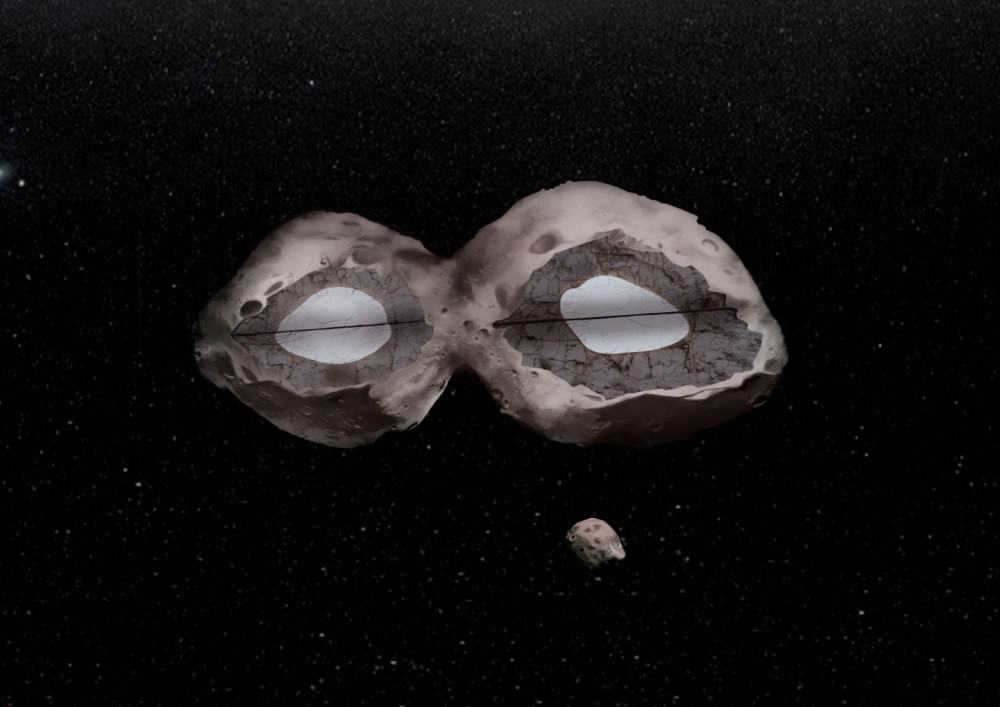
Hector was first discovered in 1907, but it wasn’t until the 21st century that scientists were able to observe it. This was due to its location, which is much closer to Jupiter than Earth, as well as its low reflectivity. Upon closer examination, it was found that Hector is shaped like a bean or a dumbbell, with two massive parts that are held together by gravity.
It takes Hector nearly 12 years to complete one orbit around the Sun. Additionally, it has a rotation rate of less than 7 hours, which is similar to other asteroids.
8. Sylvia
Sylvia is not just one asteroid, but a complex system consisting of two satellites called Romulus and Remus. Furthermore, the main asteroid itself is not a solid object, but rather a collection of small rocks held together by gravity. This is evident from Sylvia’s relatively low average density.
The Sylvia system completes one revolution around the Sun every 6.5 years, while its rotation around its own axis takes slightly over 5 hours. Additionally, Sylvia’s size can vary by up to 10% during its orbit.
7. David
In order to adhere to tradition, this asteroid had to undergo a slight renaming. Its discoverer, Raymond Dugan, originally named it David in honor of Professor David Todd. However, it was customary to give asteroids female names, so the name was changed.
Using the largest telescopes available at the time in Hawaii, scientists were able to determine that David’s size is at least 231 kilometers and identified a massive crater on its surface. Interestingly, when calculating David’s mass, the results showed a significant range of values. The asteroid’s year lasts 5.6 years, while its day lasts just over 5 hours.
The large asteroid group contains several counterparts, but the asteroid Europa stands out as being lighter. Astronomers have hypothesized that this is due to its composition of porous matter. Additionally, Europa’s faint luster suggests that it contains carbon-containing compounds.
Europa is unique in its size, measuring 302.5 kilometers in diameter. It follows an elongated orbit, with its distance from the Sun ranging from 413 to 512 million kilometers. Interestingly, a day on Europa lasts only 5.6 hours, while a year lasts just 5.5 Earth hours.
5. Interamnia
can be paraphrased as follows:
5. The city of Interamnia
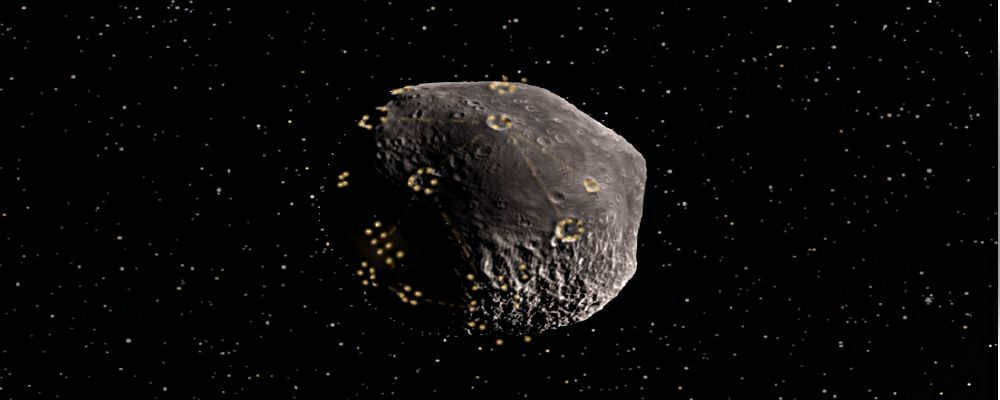
The largest asteroid known as Interamnia continues to puzzle scientists. Its diameter measures 326 kilometers, and it takes approximately 5.4 years for Interamnia to complete its orbit around the Sun. Additionally, Interamnia has a relatively short day, lasting just under 8 hours. However, astronomers face challenges in gathering information about the asteroid’s composition due to its distance from Earth and its incredibly dark surface. Even basic physical characteristics have not been directly observed, but rather inferred from Interamnia’s transit across a bright star.
4. Hygeia
Hygeia is a Greek goddess associated with health, cleanliness, and hygiene. She is often depicted as a young woman holding a serpent or a cup, symbolizing the healing arts. In Greek mythology, Hygeia is the daughter of Asclepius, the god of medicine, and she played a role in the prevention and cure of diseases.
Hygeia’s name is derived from the Greek word “hygieia,” which means “health.” She was worshipped as a protector of health and a bringer of good health. Temples and sanctuaries were dedicated to her, and people would offer sacrifices and prayers to seek her blessings and protection.
In modern times, Hygeia’s influence can still be seen in the field of public health and hygiene. The word “hygiene” itself is derived from her name and refers to practices that promote health and prevent the spread of diseases. Hygeia serves as a reminder of the importance of maintaining cleanliness and taking care of one’s health, both physically and mentally.
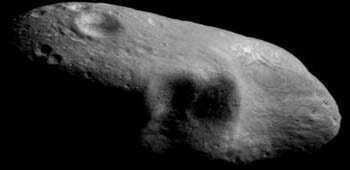
The asteroid, which was named after the goddess of well-being, was found quite belatedly – in 1849. Hygeia is positioned at a considerable distance from Earth when compared to other sizable asteroids, and its surface reflects a minimal amount of light.
On Hygeia, which spans 407 kilometers in diameter, a year lasts for 5.5 Earth years, while the length of a day surpasses that of Earth by three hours.
3. Pallada
can be paraphrased as:
3. Athena
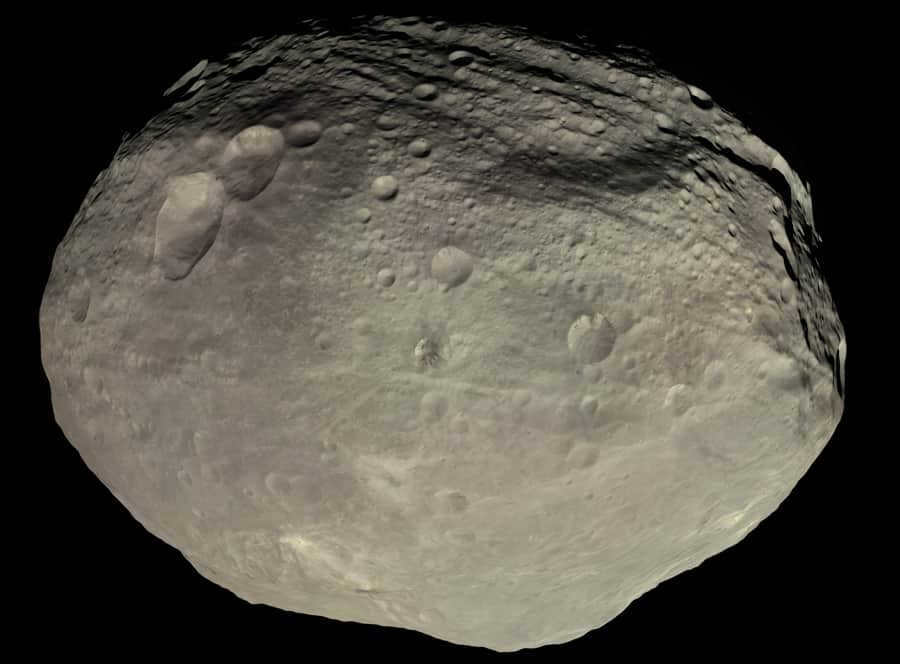
Pallade is the name of the largest asteroid after Ceres and Vesta. It was discovered by Heinrich Olbers in 1802, making it the second asteroid to be discovered. Pallade used to hold the second place in both size and discovery order, but after further measurements, it was determined to be the third largest.
With a diameter of 512 kilometers, Pallade follows an inclined and highly elongated oval orbit, resulting in a year on Pallade lasting more than 4.5 Earth years.
2. Vesta
Vesta is a popular open-source web hosting control panel that provides a user-friendly interface for managing websites and servers. It offers a wide range of features, including domain management, email configuration, database management, FTP access, and more. With Vesta, users can easily install and manage popular web applications like WordPress, Joomla, and Drupal. It also includes a powerful file manager that allows users to upload, download, and edit files directly from the control panel. Vesta is known for its simplicity and ease of use, making it a great choice for both beginners and experienced users.
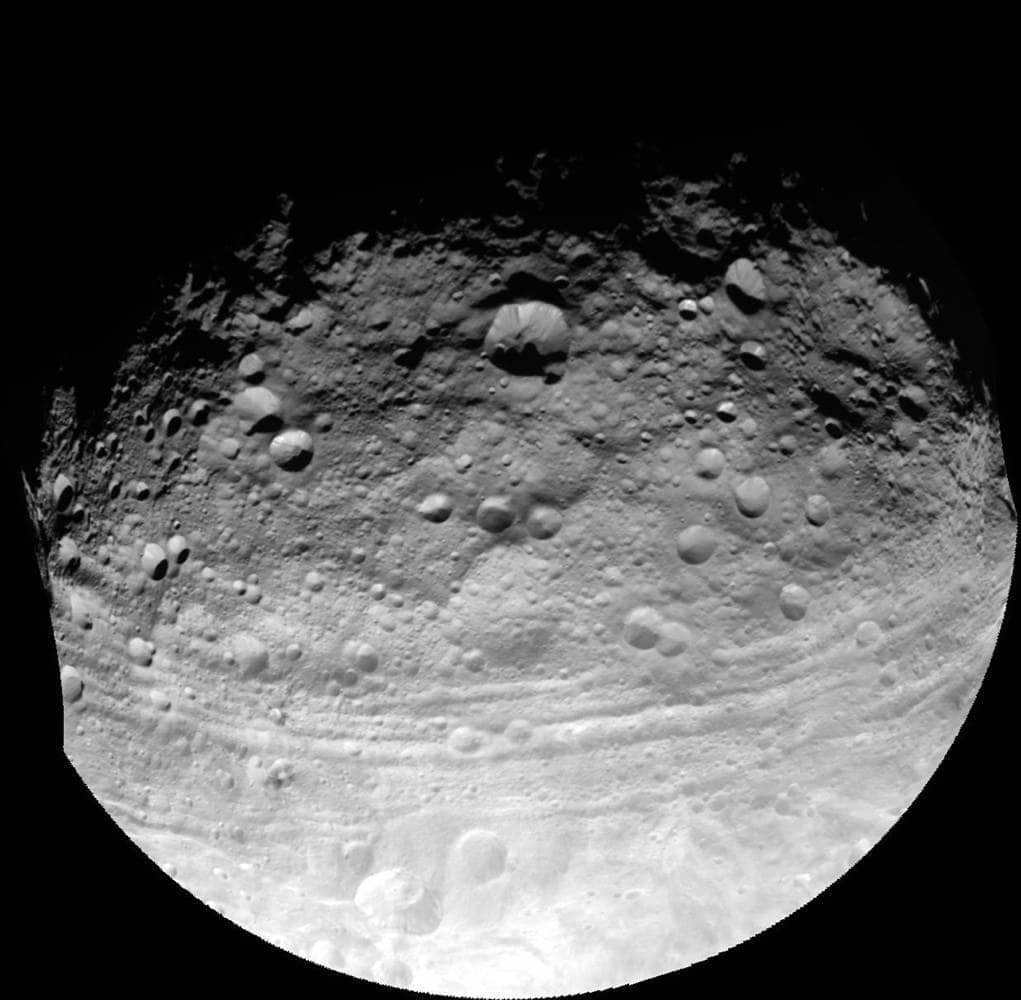
Vesta, the second largest asteroid in our solar system, is only slightly smaller than Pallada. It has an average diameter of 525 kilometers and a maximum diameter of 573 kilometers, giving it a rather irregular shape.
The surface of Vesta is marked by numerous deep craters, including the Reyasylvia crater, which is comparable in size to the asteroid itself. In the center of this crater, there is a mountain that rises 22 kilometers above its floor. Scientists are still perplexed by how Vesta managed to survive the impact of such a colossal force.
1. Ceres
Ceres is an object located in the asteroid belt between Mars and Jupiter. It is the largest object in the asteroid belt, with a diameter of about 590 miles. Ceres is classified as a dwarf planet and is the only one located in the inner solar system. It was discovered in 1801 by Italian astronomer Giuseppe Piazzi. Ceres has a rocky core and is thought to have a layer of ice beneath its surface. It is believed to have a thin atmosphere composed mostly of water vapor. Ceres is currently being studied by NASA’s Dawn spacecraft, which arrived at the dwarf planet in 2015.

Up until 2006, Ceres held the title of the largest asteroid. It was initially discovered by Giuseppe Piazza and was classified as an asteroid for 200 years until it was reclassified as a minor planet by the International Astronomical Union. Despite this decision by astronomers, Ceres falls short of being considered a planet. With a diameter of 950 kilometers, it is nearly five times smaller than Mercury, which became the smallest planet after the disqualification of Pluto.
Ceres stands out from smaller asteroids due to its nearly perfect spherical shape. Approximately one-third of the asteroid is composed of ice, while the rest is made up of iron-bearing ores and carbonates. Ceres orbits the Sun between Jupiter and Mars and has a year that lasts over 4.5 Earth years. Additionally, Ceres has a shorter day than Earth, completing one revolution around its axis in just 9 hours.
*The editorial board of Zuzako.com has reviewed and selected the best options. The criteria for selection are subjective and this material is not intended to be an advertisement or a purchasing guide. It is recommended to consult a specialist before making any purchases.
Space is a captivating and elusive realm that holds both fascination and trepidation for many. The allure of exploring the unknown depths of space is not limited to scientists alone. Within our very own solar system, a multitude of intriguing phenomena can be found, including asteroids. These celestial bodies, varying greatly in size, possess the potential to collide with one another, exhibiting unique movement patterns within the vast expanse of space. Scientists diligently monitor these asteroids, recognizing the catastrophic consequences that could ensue should a large meteorite approach Earth. In an effort to delve deeper into this subject, the editorial team at Zuzako has meticulously researched and compiled a comprehensive ranking of the largest asteroids, accompanied by detailed descriptions of their orbital paths. Join us as we embark on a journey to unveil the enigmatic celestial entities that exist before us.
Review of the largest asteroids and their orbital paths
Which of these options do you prefer?
Exploring Ceres
Ceres, one of the largest asteroids in our solar system, has a unique orbit that takes it between the paths of two planets – Jupiter and Mars. Interestingly, a single day on Ceres lasts only 9 hours.
What sets Ceres apart is its nearly perfect spherical shape, with a diameter of 950 km. In 2006, Ceres was reclassified from an asteroid to a dwarf planet. It revolves around the Sun, with a year on Ceres lasting approximately 4.5 Earth years.

- Vesta, which is the largest asteroid ever discovered, has been classified as a small planet due to its size.
- This celestial body is known for its abundant deposits of carbonates and iron ores.
Vesta
Vesta, with an average size of 525 km and a maximum diameter of 573 km, is the second largest asteroid after Pallada. The slight difference in diameter is attributed to its irregular and slightly elongated shape. One of Vesta’s notable features is the presence of numerous craters, including Reyasylvia, which is almost the same size as the asteroid itself. Furthermore, Vesta is positioned in the asteroid belt between Jupiter and Mars.

- It possesses the largest crater among all asteroids.
- Its shape is irregular, resulting in variations in its diameter.
- The core of Vesta is composed of metal.
Pallada
Pallada, which is ranked third among asteroids, was discovered in 1802 and is considered the second in terms of its discovery date. It was initially believed to be the second largest asteroid, but after precise measurements, it was surpassed by Vesta. Pallada has a diameter of 512 kilometers and follows an inclined orbit, giving it an oval-like appearance. As a result, a year on Pallada is equivalent to 4.5 Earth years.
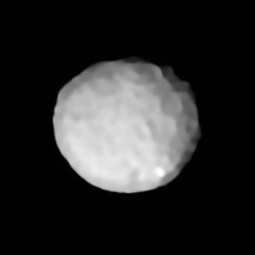
- It travels in an unusual path around the sun
- It is the second asteroid to be discovered
- Previously, it held the title of the second largest asteroid
Hygeia.
The sighting of an asteroid like Hygeia only occurred in 1849 – this celestial object was named after the goddess of health. Despite its considerable size, the asteroid is located at a significant distance from Earth, and its surface appears dark due to low light reflection. It has a diameter of 407 kilometers and its orbital period is equivalent to 5.5 Earth years.

Interamnia
Scientists obtained information regarding the movement and size of Interamnia when the asteroid was illuminated by a luminous star.
Even in 2020, Interamnia remains a perplexing enigma for scientists. This is primarily due to its significant distance from Earth and its dark surface, which hinders the acquisition of comprehensive data. With a diameter of 326 kilometers, Interamnia completes one orbit in 5.4 Earth years and has an 8-hour day.
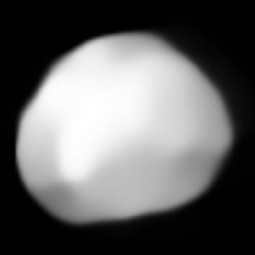
Europa
What sets Europa apart is its relatively small mass compared to other large asteroids. Researchers have put forward a theory that this discrepancy is due to its composition of porous rocks, which are lighter in weight. With a diameter of 302.5 kilometers, Europa follows an elongated orbit and experiences a short day lasting just 5.6 hours.
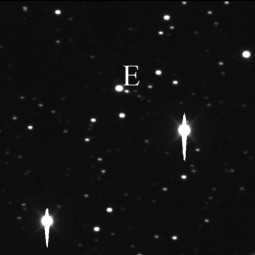
David
The initial name of the asteroid was David, in tribute to scientist David Todd. However, following the tradition of assigning feminine names to celestial bodies, it was later given a different name.
Despite being situated at a considerable distance from Earth, astronomers managed to determine the asteroid’s diameter to be 231 kilometers using the most advanced telescope technology. Additionally, they discovered the presence of a large crater on its surface. It is worth noting that when attempting to calculate its mass, scientists obtained figures that differed by a factor of two.
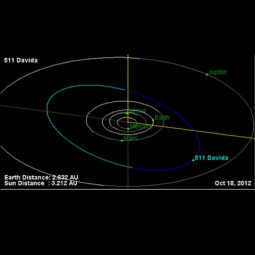
Sylvia
Sylvia stands out due to its possession of multiple individual satellites. Rather than being a solid mass, this asteroid is composed of various small stones that are bound together by strong gravitational forces. This conclusion was reached by scientists based on its relatively low mass. Furthermore, the diameter of Sylvia can fluctuate by up to 10% as it moves along its orbit.
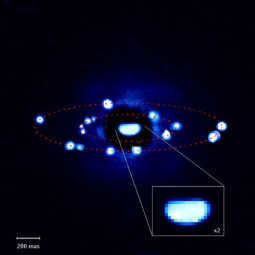
Hector
The asteroid known as Hector was only discovered in 1907, primarily due to its considerable distance from Earth and its dimly reflective dark surface. One notable characteristic of this celestial body, measuring about 370 km in diameter, is its rather peculiar shape, which closely resembles that of a peanut, dumbbell, or bean, as can be observed from the available photographs. Interestingly, Hector is not composed of interconnected rocks, but is rather held together solely by the force of gravity.
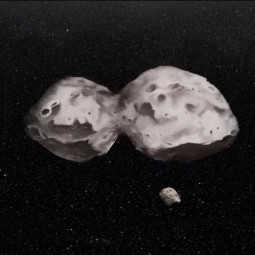
Euphrosyne
Known as Euphrosyne, this asteroid is the largest one with a diameter of only 256 km. Its unique characteristic is its high carbon emissions, which make it difficult to observe. Despite its small size, Euphrosyne is relatively close to Earth. This celestial body follows an orbit that is almost perpendicular to the plane of the ecliptic.
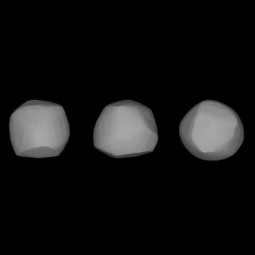
Curious details about asteroids within our solar system: handpicked by Zuzako’s editors
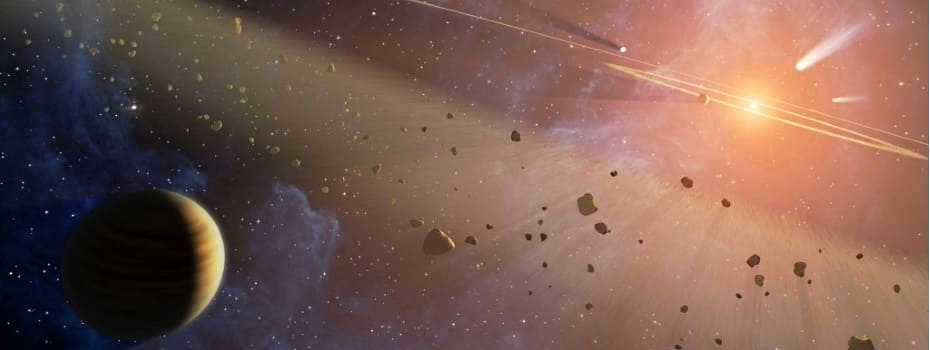
The compilation of the most massive, voluminous, and extensive celestial bodies encompasses renowned asteroids that have undergone thorough examination throughout numerous decades. Upon acquainting oneself with such entities, it becomes worthwhile to ponder upon their commonalities and the specific attributes that researchers accentuate.
The editorial team at Zuzako has collated several scientific particulars that might captivate individuals who have embarked on their exploration of outer space and asteroids:
- Each asteroid is assigned to a distinct spectral class and typically falls into categories such as iron, carbon, and flint.
- While in space, these celestial bodies are referred to as asteroids, but once they enter the Earth’s atmosphere and fly through it, they are known as meteors, and after impact, they become meteorites.
- In order to pose a catastrophic threat to our planet, a colliding object must have a minimum diameter of 10 kilometers.
- If the object has a small mass, it can undergo significant changes in shape, deviating greatly from the typical “spherical” concept. It is not uncommon to observe shapes such as ellipses, bone-like structures, cones, and more.
- In terms of appearance, these objects often consist of aggregated masses formed by individual pieces of rocks fused together.
- Each asteroid is composed of specific minerals and other substances. When asteroids collide with each other or impact a planet, they undergo various chemical reactions and can alter their composition.
- When discussing larger objects, it is worth noting that they, similar to certain planets, may have satellites orbiting them and even possess their own rings, as exemplified by Chariklo.
- Scientists have discovered layers of ice and even flowing water on some asteroids.
- While humans have never set foot on an asteroid, specially designed spacecraft have visited them and even returned samples of their soil.
Exploring the vastness of space and the wonders it holds, such as asteroids, continues to captivate the minds of many individuals eager to unravel the mysteries of the universe. This article, crafted by the Zuzako editorial team, serves as a brief introduction to the largest asteroids and their movements. It provides valuable insights for space enthusiasts who yearn for a deeper understanding of celestial bodies. Embrace the journey of discovery, expand your knowledge, and stay connected!
Don’t forget to share this fascinating article with your friends on social media.
Disclaimer: The information presented in this article is based on the expert opinion of the author.
Among the most widely discussed doomsday scenarios is one involving the catastrophic impact of an asteroid, resulting in the extinction of all life on Earth and the downfall of our civilization.
The arrival of a deadly asteroid can be both anticipated and unforeseen. Very recently, asteroid 2018 GE3 came perilously near to Earth. It was detected not merely in the previous year, as its designation implies, but mere hours before it approached our planet. After four days of monitoring, it was determined that it did not pose a threat to our Blue Planet. We are now fully informed about it, so there is no need to be concerned about its next close approach.
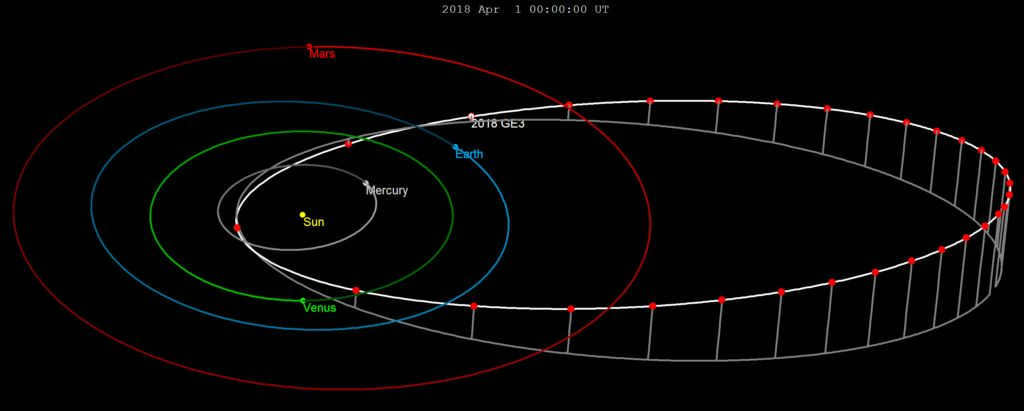
Nevertheless, certain asteroids have been observed to have orbits that are perilously close to Earth. These asteroids are traversing our part of the solar system, and even the slightest alteration to their orbits could result in a catastrophic collision with our planet. We will now delve into the details of the most hazardous celestial bodies in our solar system that pose a significant threat to Earth.
This small asteroid, part of the Apollo group, stands out because it holds the highest position on the Palermo Collision Hazard Scale. At present, 1950 DA has been classified as the most perilous asteroid to Earth, with a rating of minus 1.42.
The asteroid is expected to make its closest approach to us in 2032, but the closest proximity – and potential collision – could occur on March 16, 2880. In such an event, if human civilization still exists in 800 years, catastrophic consequences will be in store. Our future generations need to be prepared for significant climate change and the extinction of a substantial portion of the Earth’s biosphere.
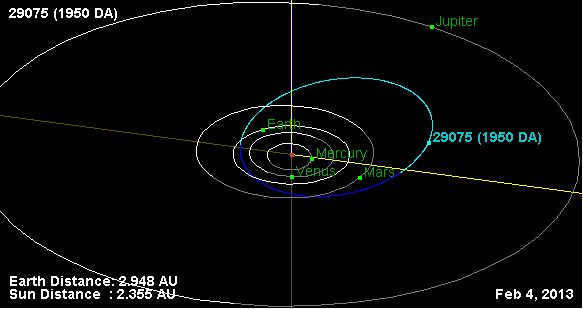
The largest asteroid, 1950 DA, is a member of the Apollonian group of near-Earth asteroids. These asteroids have orbits that intersect the Earth’s orbit from the outside, meaning they are generally located beyond the Earth’s orbit but still cross it in the aphelion region. They are named after the first discovered asteroid in this group, Apollo (1862). 1950 DA has an elongated elliptical orbit that not only crosses the Earth’s orbit but also intersects with Mars’ orbit during its journey around the Sun. This makes it a member of the Mars-crosser family as well.
It takes more than two years for it to complete its orbit around the Sun, and during its journey, it frequently comes close to Earth at relatively short distances. This proximity, along with its long period of observation and moderate inclination of its orbit to the ecliptic plane, has allowed for the accurate measurement of its physical characteristics.
The average diameter of this celestial object, which has the potential to intersect with our planet, is approximately 1.3 kilometers. The exact mass of 1950 DA is not known, but various calculations estimate it to be between two to four billion tons.
The asteroid’s relatively small size and mass, in cosmic terms, make it vulnerable to the Yarkovsky effect, which has the potential to significantly alter its orbit. This effect, initially proposed by Russian engineer Ivan Yarkovsky in 1900, involves the emission of a weak jet pulse caused by the asteroid’s surface being heated by solar radiation during the day and cooling at night. Like other celestial bodies, the asteroid experiences day and night as it rotates on its axis. This unique “photon engine” can provide additional acceleration and, consequently, lead to a shift in its orbit. Such a change could have disastrous consequences for the Earth.
101955 Bennu (1999 RQ36)
Bennu is ranked as the second most hazardous asteroid to our planet. Its Palermo scale rating is -1.71. By 2135, it will be within a mere 300,000 kilometers of Earth, which is even closer than the Moon. The potential impact date ranges from 2175 to 2199, during which it will have 78 close approaches to Earth. Bennu completes one orbit around the Sun approximately every 1.2 years.
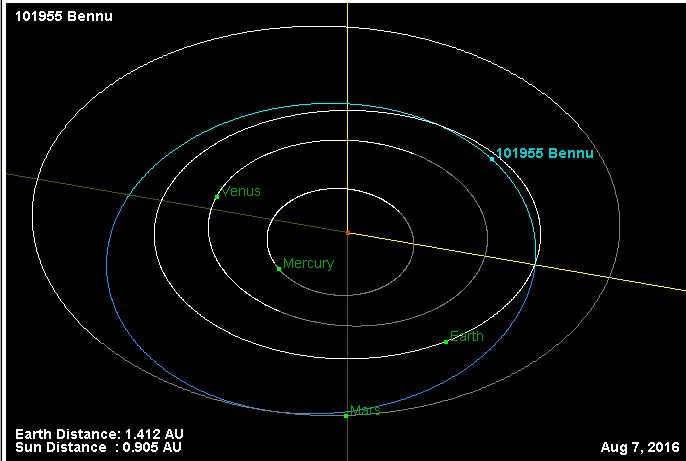
The asteroid’s elliptical orbit has a major axis length of approximately 1.13 astronomical units. Similar to 1950 DA, Bennu belongs to the Apollo group.
With an average diameter exceeding 510 meters and a mass ranging from 60 to 78 million tons, this asteroid’s impact on Earth would be equivalent to detonating a 1,150 megaton TNT bomb. To put this into perspective, the Tsar Bomba, the most powerful explosive device ever tested by humans on Earth, had an explosive power of around 58 megatons in TNT equivalent.
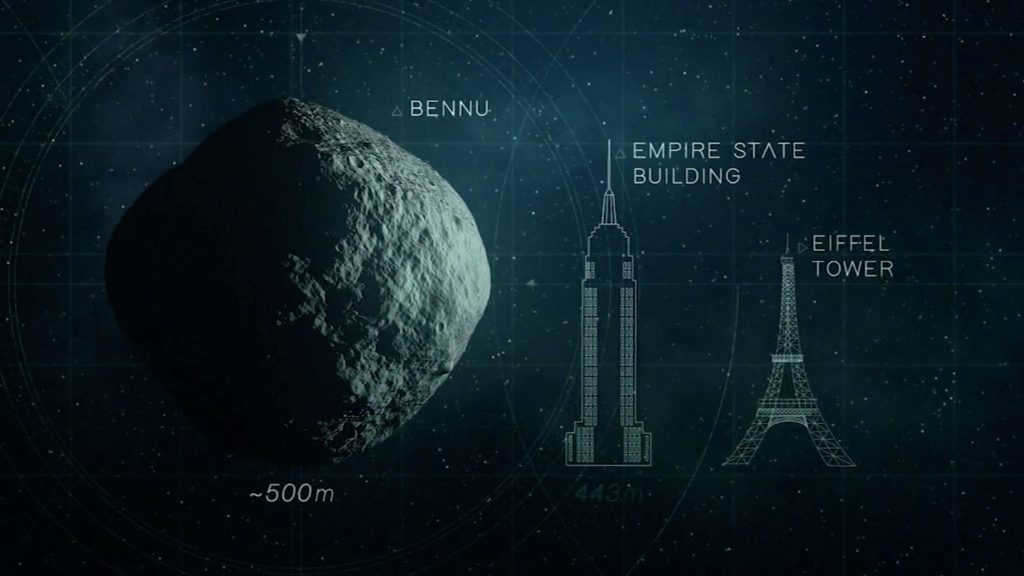
The largest asteroid in our solar system is known as Bennu. It has gained attention not only for its size, but also because it is the target of a space probe mission called OSIRIS-REx. This mission, launched by NASA in September 2016, aims to collect samples from Bennu and bring them back to Earth in 2023. The spacecraft is expected to “pluck” about two kilograms of regolith from the asteroid. Additionally, OSIRIS-REx will study Bennu’s characteristics and measure the strength of the Yarkovsky effect in close proximity to the asteroid.
410777 (2009 FD)
Ranked third among the most perilous asteroids, 2009 FD stands out as a binary asteroid, meaning it consists of two co-orbiting celestial bodies. Similar to a double star, these components are gravitationally bound and orbit around a shared center of mass. The larger component of this system measures between 120 and 180 meters in diameter, while the smaller one ranges from 60 to 120 meters. Together, they contribute to a total mass of approximately 3.2 million tons.
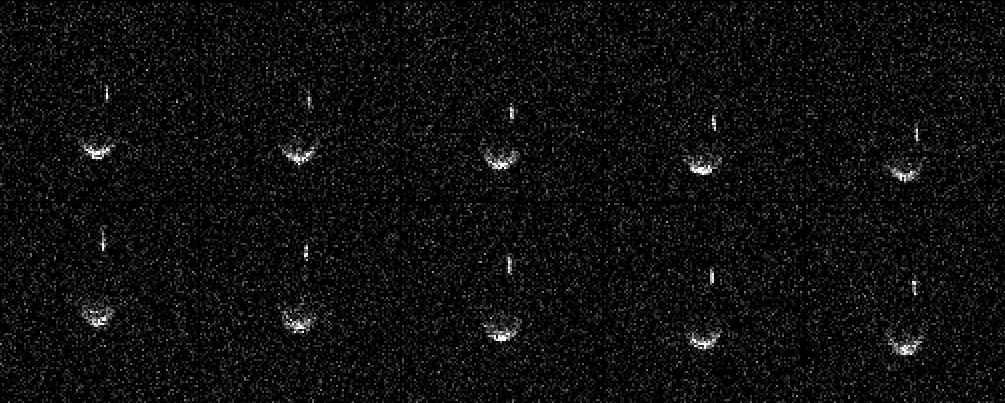
According to scientists, there have been instances of double asteroids impacting the Earth. This can be seen in certain impact craters, like the Clearwater double crater in Quebec, Canada, which is believed to have been caused by the impact of a binary asteroid. The Clearwater crater formed approximately 290 million years ago during the Permian period. 2009 FD is also classified as part of the Apollo group due to its orbital parameters. It takes approximately 458 Earth days for 2009 FD to complete one revolution around the Sun.
This is the third and final asteroid that requires special attention today, according to the Palermo scale. Its index is -1.78. This scale is used to calculate the potential danger of comets and asteroids colliding with Earth. If the result is -2 or lower, the probability of collision is virtually nonexistent. If the result is between -2 and 0, careful observation is required. If the result is 0 or higher, it is likely that a collision cannot be avoided.
The last time 2009 FD passed by Earth was on October 29, 2015. At that time, the distance between our planet and the asteroid was approximately 6.27 million kilometers. The next encounter will occur on November 3, 2020, at a distance of about 25.91 million kilometers. The most dangerous period for Earth will be between 2185 and 2198, with the closest approach to the planet occurring in 2198.
One topic that is certainly worth discussing is Apophis. While NASA has dismissed the possibility of Apophis colliding with Earth in 2036, the European service NEODyS, supported by ESA, is not yet ready to remove the asteroid from its risk list. Currently, Apophis, along with the three aforementioned asteroids, is categorized as “special” – meaning that European researchers still consider the chance of an undesired encounter with Earth to be possible. On the Palermo scale, Apophis has a score of minus 2.83.
Apophis has a non-uniform shape, with a largest diameter measuring 325 meters. It takes 325 days for Apophis to complete one orbit around the Sun, and the inclination of its orbit to the ecliptic plane is 3.3 degrees. Additionally, Apophis has an average distance from the Sun of 0.92 astronomical units (a.u.). These parameters indicate that Apophis’ orbit is very close to that of Earth, but with a significantly higher eccentricity of 0.191 (compared to Earth’s 0.016). Unlike the previous three asteroids, Apophis belongs to the Aton group, which is named after the asteroid (2062) Aton. The Aton group’s orbits generally lie inside Earth’s orbit and intersect it from the inner side. At its farthest point from the Sun (aphelion), Apophis is farther away than Earth is at its closest point (perihelion).
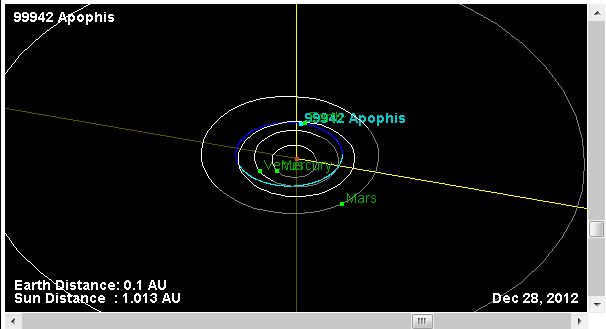
Apophis was first spotted in 2004 and immediately caught the attention of astronomers. Initial calculations predicted that the asteroid could potentially collide with Earth in 2029, posing a significant threat. The danger level of this potential impact was initially estimated at four points on the Turin Scale, a scale designed to assess the likelihood of a collision between an object and our planet. Unlike the Palermo Scale, which is primarily used by experts, the Turin Scale was created with the purpose of informing the general public about potential collision threats.
This scale utilizes a range of values ranging from zero to ten. A score of zero signifies that the likelihood of a collision with the Earth is incredibly minuscule, to the extent that it falls within the margin of error for observations. On the other end of the scale, a score of ten denotes an impending impact that is unavoidable and will result in significant global ramifications. The severity of the threat is assessed by taking into account both the mathematical probability of impact and the kinetic energy associated with the collision. To date, no object has ever received a rating higher than four. Furthermore, as of the present moment, no celestial body has been assigned a value other than zero.
When it comes to Apophis, it holds the distinction of being listed in the Guinness Book of World Records as the most perilous asteroid ever observed. Apophis maintained a significant rating on the Turin scale until August 2006, when it was downgraded to zero after refining its trajectory. According to the most recent observations in 2014, Apophis has an estimated diameter of around 370 meters. If a collision with Earth were to occur, the impact could potentially trigger a significant regional or even global catastrophe.
2010 AU118
Asteroid 2010 AU118 holds the fourth position on the Palermo scale, scoring a hazard index of -2.72. The estimated size of this asteroid is 1.9 kilometers, making it the largest object recorded in NASA’s collision monitoring system, Sentry. The experts at NASA continuously monitor the latest data observations of asteroids and calculate the likelihood of their collision with Earth.
Unlike the Apollo and Aton groups mentioned earlier, 2010 AU118 belongs to the previously unmentioned Amur group (named after asteroid (1221) Amur). It, along with other asteroids in the group, does not intersect with Earth’s orbit but approaches it from the outer side. It takes 754 days for 2010 AU118 to complete one revolution around the Sun. From 2020 to 2112, there are a total of 38 potentially dangerous approaches from this asteroid.
By the way, there is another category of asteroids that we have not yet discussed. These are the Athyrs, which are named after the asteroid (163693) Athyra. Unlike the Aton, Apollo, and Cupid groups, the Athyrs have orbits that are closer to the Sun than the Earth’s perihelion, meaning they are located inside the Earth’s orbit.
Compared to the other groups, the Athyrs are the smallest group of near-Earth objects. Currently, none of the Athyrs are considered to be a threat to us. So far, only 18 asteroids from this group have been confirmed, but it is possible that there are more that have not yet been discovered.
The reason for this figure can be attributed to the fact that these asteroids are challenging to investigate from the Earth due to their close proximity to the Sun and their compact size. The observation of these asteroids is only possible during twilight, right before sunrise or immediately after sunset. There is a possibility that in the future, a celestial object might emerge among them that is too close to the Earth. The alteration of its orbit, either through its close encounter with other planets or due to the Yarkovsky effect, could potentially classify it as a threat to humanity.
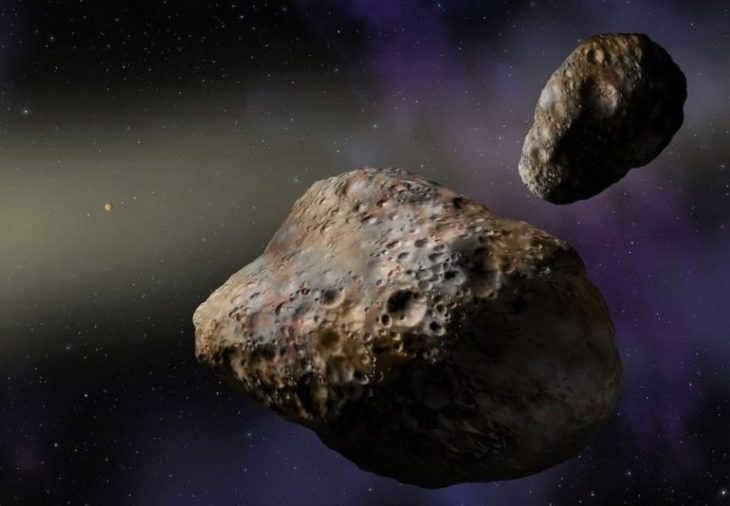

Is it possible for human civilization to vanish? This is a question that has long intrigued scientists. Nowadays, the majority of them have reached the conclusion that if we don’t annihilate ourselves, the greatest asteroids, with a diameter exceeding 3 kilometers, have the potential to do so. Surviving a collision with such an entity is highly unlikely for humanity.
The solar system comprises around 700,000 objects with various shapes and sizes. Among them, asteroids pose the most significant threat to Earth. The larger they are, the more perilous their impact.
This article will delve into the largest asteroids, their trajectories, and their impact.
What is the nature of asteroids
Astronomers have been aware of these celestial bodies since ancient times, but it was only in the early 2000s that the general public became informed about them. This was due to media panic caused by the approach of the asteroid Alophis to Earth. It was estimated that a collision could potentially result in the death of a quarter of the world’s population. Fortunately, nothing disastrous occurred as the menacing object passed by, but public interest remained.
So, what exactly are asteroids, which ones are the largest, and how do they move in reality? Let’s delve into the details.
An asteroid is a small celestial body, compared to planets, that orbits the Sun and lacks an atmosphere.
The primary location of these objects is the asteroid belt, which is situated between the orbits of Mars and Jupiter. According to ancient mythology, this is where the planet Phaethon once existed before mysteriously vanishing.
Astronomers hypothesize that the planet indeed existed but was shattered into fragments due to some catastrophic events. Fortunately, the asteroid belt poses no direct danger to our planet, as it is located at a considerable distance from Earth.
What are the largest asteroids in the solar system?
Ceres is considered to be the largest asteroid in the solar system. It’s quite an unlucky one, as it has been classified as both a full-fledged planet and an asteroid in the past. However, it is now officially recognized as a dwarf planet. Ceres was first discovered by Giuseppe Piazzi in 1801.
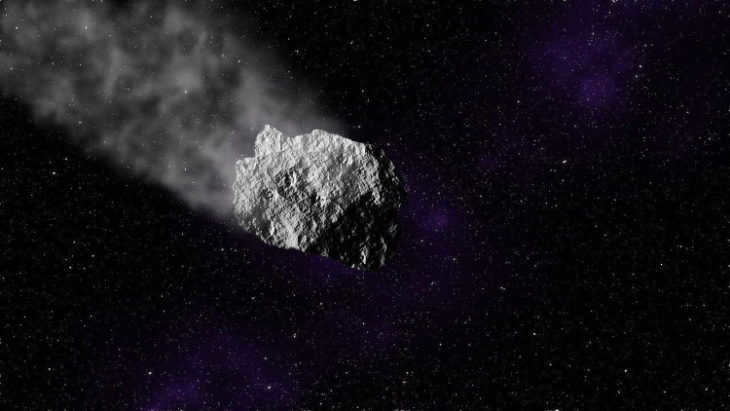
The size of this small celestial body is slightly less than 1000 kilometers. Ceres has a spherical shape. Its core consists of rocks, and inside there is a significant amount of frozen water.
Pallada is a carbonaceous asteroid, ranking second in terms of size after Ceres. It has a diameter of 532 kilometers. One notable characteristic is the tilt of its rotational axis, which is 34 degrees, whereas most other objects rarely exceed 10 degrees. The distance between Pallada and the Sun is constantly changing.
Ranked third on the list is Vesta, which has a diameter that is nearly half the size of Ceres. However, it holds the title for being the heaviest asteroid. Vesta’s reflectivity is four times greater than its larger counterparts. It makes a close approach to Earth every four years, with a minimum distance of 177 million kilometers. Unlike other asteroids, Vesta does not cross the Earth’s orbit. Its core is primarily composed of heavy metals, while the crust consists of rocks. Occasionally, Vesta can be observed from Earth with the naked eye, but no more than once every three years.
Other notable asteroids among the top ten largest include: Hygeia, Interamnia, David, Sylvia, Eunomia, Euphrosyne, and Hector.

